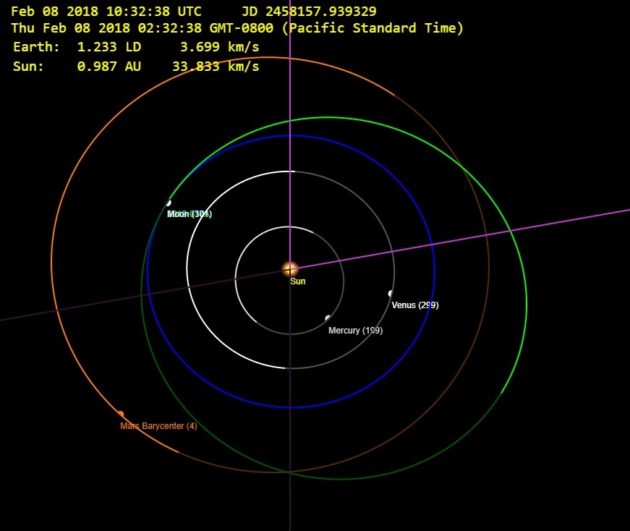
It took a day or two, but astronomers have figured out where the Tesla Roadster launched into deep space aboard SpaceX’s Falcon Heavy rocket is going. And it’s not the planet Mars or the asteroid belt.
Observations of the Roadster, which has a spacesuit-clad mannequin named Starman riding in the driver’s seat, indicate that it’s in an elliptical orbit around the sun that will take it just outside the orbit of Mars and then back to slightly within Earth’s orbital distance.
If you run out the orbit over the foreseeable future, it’s not on a path to run into Earth, or Mars, or any asteroids.

SpaceX’s billionaire CEO, Elon Musk, raised some eyebrows hours after Tuesday’s launch when he reported that the Roadster received more of a push from the Falcon Heavy rocket’s upper stage than expected. He said it was on a course that would take it deep within the asteroid belt between Mars and Jupiter.
Later observations and calculations have shown that it won’t go that far out. Its farthest distance from the sun will be about 158 million miles — a point that it’s slated to reach on its first go-around on Nov. 19.
It’ll come back to just inside Earth’s orbital distance on Sept. 1, 2019, but our planet won’t be anywhere near it at the time. Or any other time.
Jonathan McDowell, an expert orbit-watcher from the Harvard-Smithsonian Center for Astrophysics, provided the lay of the land in a series of tweets:
https://twitter.com/planet4589/status/961393591078785024
https://twitter.com/planet4589/status/961394843648954368
https://twitter.com/planet4589/status/961423941838483461
https://twitter.com/planet4589/status/961471102445850624
https://twitter.com/planet4589/status/961473844023320576
https://twitter.com/planet4589/status/961474760134877184
https://twitter.com/planet4589/status/961474859728596992
https://twitter.com/planet4589/status/961476629976535040
https://twitter.com/planet4589/status/961605953731821568
https://twitter.com/planet4589/status/961612638567518208
https://twitter.com/planet4589/status/961614126404505600
CBS News quoted McDowell as saying that the orbit is likely to remain stable for centuries to come, but probably not for the millions of years that Musk was hoping for. That’s because of subtle influences from temperature shifts and Jupiter’s gravitational influence.
“It’s tiny, but over timescales of millions of years it’s enough to shrink the orbit and make the thing fall into the sun,” McDowell told CBS News. “So it’s a race between does that happen before some Jupiter perturbation ejects it from the system.”
If aliens or spacefaring humans come across the Roadster before it’s gone, the car’s Blue Book value might be a bit disappointing. SETI Institute senior astronomer Seth Shostak told NBC News that cosmic rays and the sun’s ultraviolet radiation are likely to degrade the car’s cherry-red paint job (and Starman’s spacesuit) over time. Tiny bits of space grit could ruin the finish as well.
https://twitter.com/planet4589/status/961700958030966784
https://twitter.com/renerpho/status/961788480409014273
Bookies are already laying odds on where the Roadster will crash: Sportsbet.com.au reports that asteroids are the favored targets, with a $1 bet potentially producing a $2.50 payoff. The sun is No. 2 on the list ($3.50), and a $1 bet will get you $101 if the car crashes into a UFO.
There are two downsides to the proposition, however. First, you have to sign in from a locale where online betting is allowed. And then there’s the little matter of having to wait millions of years to collect your winnings.
As David Bowie sang in the song “Starman”: “Let the children lose it, let the children use it.”


